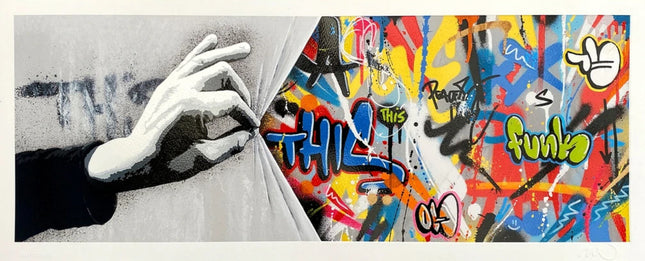
Street Art
-

Martin Whatson Sneak Peek Silkscreen Print by Martin Whatson
Sneak Peek 7-Color Hand-Pulled Limited Edition Silkscreen Print on 300gsm Somerset Satin Paper by Martin Whatson, a Rare Street Famous Pop Artwork Artist. 2021 Embossed Stamp Limited Edition Artwork Size 24.4x9.84. Paper embossed around the curtain edge for a 3D effect with the graffiti in the background. It was stamped by Martin Whatson & Graffitiprints. Artistic Elements of "Sneak Peek" "Sneak Peek" is a limited edition silkscreen print by Norwegian artist Martin Whatson, known for his distinctive fusion of grayscale imagery with vibrant street art elements. This piece, created in 2021, is a 7-color hand-pulled print on 300gsm Somerset Satin paper, noted for its smooth finish and high quality, a favored medium for fine art prints. The artwork features an embossed stamp and is 24.4 inches by 9.84 inches. One of the most striking aspects of "Sneak Peek" is the embossed paper around the curtain edge, which lends a 3D effect to the graffiti showcased in the background. This technique highlights Whatson's innovative approach to printmaking, combining precision with traditional techniques' tactile quality. Martin Watson Signature Style Whatson's art is a visual commentary on the stark contrasts between the urban landscape and the human experience. In "Sneak Peek," the use of grayscale to depict the hand and the curtain symbolizes the often monochrome and mundane aspects of life. At the same time, the colorful graffiti in the background represents the vibrant, often hidden layers of the city and its expressive street art culture. Integration of Street Pop Art & Graffiti Artwork "Sneak Peek" embodies the spirit of street pop art and graffiti through its combination of classical art references and contemporary graffiti techniques. Martin Whatson and Graffitiprints, a hallmark of authenticity and a nod to the collaborative nature of street art, stamp the piece. Whatson's work is a dialogue between the traditional and the new, and this print is a testament to that ongoing conversation. In conclusion, "Sneak Peek" is a collectible piece that encapsulates Martin Whatson's unique perspective within the street pop art and graffiti movement. It showcases his skillful blending of different art forms to create something that is both accessible and complex, offering a window into the layered world of street art.
$504.00


